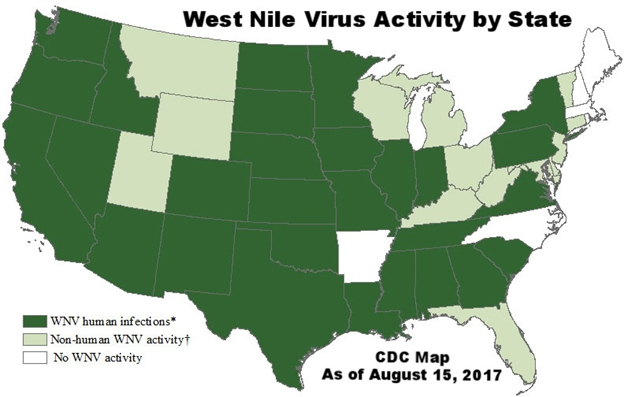West Nile Virus (WNV)
West Nile Virus (WNV) is the leading cause of mosquito-borne illnesses in the United States. It was first detected in the United States in 1999 and has since resulted in about 2,000 deaths. The mosquito becomes infected when it takes a blood meal from a bird that carries the virus. When the female mosquito bites a human, West Nile can be transmitted to that person. West Nile Virus is now present in almost every state in the Union each during mosquito season (generally April through early November in the United States). According to the CDC in 2017, forty-three states and the District of Colombia reported WNV infections in people, birds, or mosquitoes (see image below).
Transmission
While over 150 species of mosquitoes can carry this virus, the main vector species in the United States are the Culex mosquitoes. Culex pipiens, known as the northern house mosquito, and Culex quinquefasciatus, known s the southern house mosquito are of particular concern in the DC Metro area for West Nile Virus transmission. Culex mosquitoes are active at night during the summer. Staying indoors at night, dawn, and dusk can help limit one’s exposure to WNV. WNV cannot be transmitted from human to human via a mosquito bite. A human is considered a dead-end host for WNL, meaning that the disease does not reach a high enough viral load in a person for a mosquito to pick it up from a human. The only human to human transmission of WNL is through organ donation or blood transfusion, but this is rare. WNL is only transmitted to a human from an infected bird via mosquito bite.
Signs and Symptoms
Four out of five people infected with West Nile Virus will not experience symptoms. The 20% who are affected will have flu-like symptoms such as fever, nausea, headache, muscle pain, and swollen lymph glands. Less than 1% of people develop severe symptoms. Certain people, due to their age or other underlying medical conditions, may develop acute or life-threatening symptoms such as high fever, stiff neck, stupor, coma, tremors, or seizures. The most severe form of the illness affects the central nervous system and can cause inflammation of the brain and spinal cord and cause death.
Treatment and Vaccine
There is no vaccine for West Nile Virus. People with mild symptoms generally recover within a few weeks. Those with severe symptoms often need hospitalization and receive support treatment and care.
Mosquitoes capable of transmitting West Nile Virus
The main vector species in the U.S. for WNV are Culex pipiens and Culex quinquefasciatus. These mosquitoes typically feed from evening to morning. Culex pipiens, the common house mosquito, is one of the most common mosquitoes in the U.S. and is the main culprit for West Nile transmission. They are brown or brown-grey. Culex quinquefasciatus, commonly known as the southern house mosquito, is usually brown with the head a slightly lighter in color than the rest of its body. We in the DC Metro area are at the cross-section of the northern house mosquitoes southernmost distribution and the southern house mosquitoes northernmost distribution.

